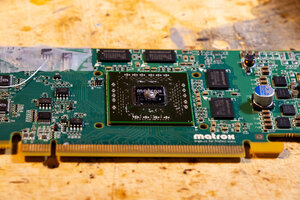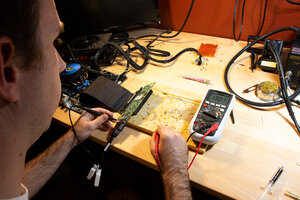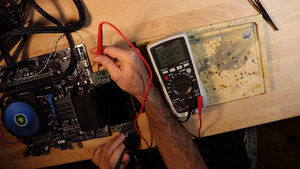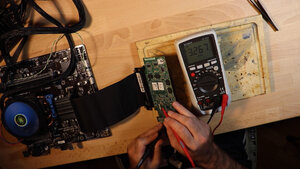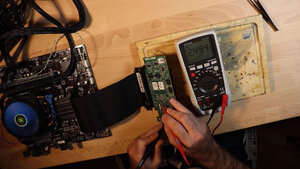Ladies! Gentlemen! Welcome back to Graphics Card Necromancy, where we routinely fail to repair dead graphics cards!
On the healing bench today, we have a really special guest, graciously provided by our very own Halon, in this Matrox M9120 Plus, which seems to have a little problem powering on.
Matrox is not a name you hear very often anymore, but they're actually still around, making really specialized PC parts, including, as I understand it, this card. Yes, that's right, this is a graphics card with 512MB of DDR2 memory, and you can actually go out and buy a brand new one right now. Maybe. If you can find somewhere that actually sells them. From what I can tell, these are typically used in specialized applications like medical imaging devices, where image quality and stability matter more than cutting edge features or compute performance. I'm curious what Halon was using it for - maybe he'll chime in later.
One thing to note here: I'm going to call the great big processing chip on this a GPU for the sake of convention, but it may not technically be one. This card does theoretically support DirectX 9 and OpenGL, but it's not really meant for playing 3D games.
Product page for it here:
https://www.matrox.com/graphics/en/products/graphics_cards/m_series/m9120pluslpx16/
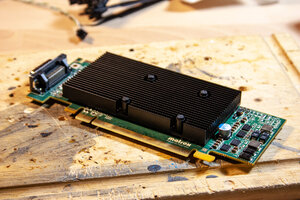
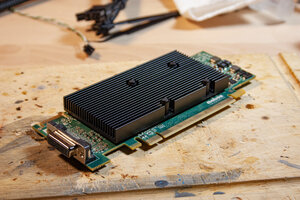

One thing I noticed is that the card is warped ever so slightly, probably thanks to the mounting pressure of the heatsink. It's not perfectly flat. It wouldn't totally shock me to find out that the reason it doesn't work is that there's a broken trace somewhere inside the card, but that's just speculation at this point. It could also be a broken solder ball under the GPU, or one of the other BGA chips on the board.
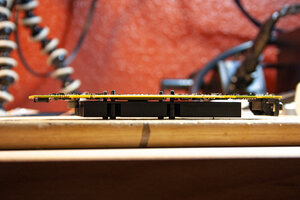
Here it is with the heatsink removed. The etching on the die is surprisingly deep. They clearly weren't terribly worried about cooling. The TIM was hard as a rock, too. Not surprising for a card this old, I guess. There's no evidence of corrosion or physical damage that I can see, though. It's surprisingly clean for a used card of this age.
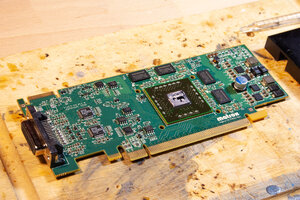
After a couple of hours of soaking with isopropanol, I was able to soften the TIM enough to scrape it off with an old gift card and my fingernail.
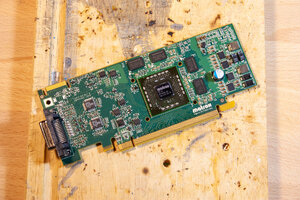
Let's take some resistance measurements.
I think this is the GPU core. This seems pretty low for a GPU this size, but it's really old, so it could be sane. It's at least not a dead short.

This is probably the memory rail.
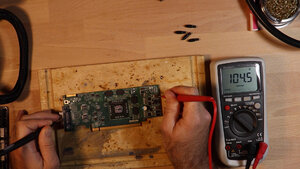
We have two more VRMs on the board, which are made up of these Richtek RT9183s. These are low dropout regulators, which work differently from the buck converters that are used for the major rails. They consist of only the tiny SOP-8 IC you see there - there aren't inductors or external MOSFETs or anything.
This is the first one. Measuring its output is going to be a problem, since the heatsink covers it once it's installed. Without a working card to check against, it's hard to say whether any of the values we see here are correct, but they at least look sane. Clearly faulty would be like, millions of ohms, or zero. 700 is probably OK.
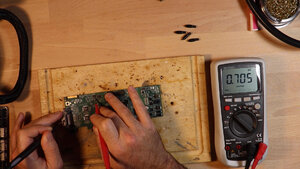
The other one is on the back of the card. Also looks sane. That's 93.5 on the meter, in case it's not clear.
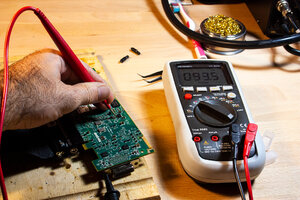
The next step is to install the card into the system and see if it works. So far, we haven't seen anything obviously amiss, besides that we're told it doesn't work. Stay tuned...
On the healing bench today, we have a really special guest, graciously provided by our very own Halon, in this Matrox M9120 Plus, which seems to have a little problem powering on.
Matrox is not a name you hear very often anymore, but they're actually still around, making really specialized PC parts, including, as I understand it, this card. Yes, that's right, this is a graphics card with 512MB of DDR2 memory, and you can actually go out and buy a brand new one right now. Maybe. If you can find somewhere that actually sells them. From what I can tell, these are typically used in specialized applications like medical imaging devices, where image quality and stability matter more than cutting edge features or compute performance. I'm curious what Halon was using it for - maybe he'll chime in later.
One thing to note here: I'm going to call the great big processing chip on this a GPU for the sake of convention, but it may not technically be one. This card does theoretically support DirectX 9 and OpenGL, but it's not really meant for playing 3D games.
Product page for it here:
https://www.matrox.com/graphics/en/products/graphics_cards/m_series/m9120pluslpx16/



One thing I noticed is that the card is warped ever so slightly, probably thanks to the mounting pressure of the heatsink. It's not perfectly flat. It wouldn't totally shock me to find out that the reason it doesn't work is that there's a broken trace somewhere inside the card, but that's just speculation at this point. It could also be a broken solder ball under the GPU, or one of the other BGA chips on the board.

Here it is with the heatsink removed. The etching on the die is surprisingly deep. They clearly weren't terribly worried about cooling. The TIM was hard as a rock, too. Not surprising for a card this old, I guess. There's no evidence of corrosion or physical damage that I can see, though. It's surprisingly clean for a used card of this age.

After a couple of hours of soaking with isopropanol, I was able to soften the TIM enough to scrape it off with an old gift card and my fingernail.

Let's take some resistance measurements.
I think this is the GPU core. This seems pretty low for a GPU this size, but it's really old, so it could be sane. It's at least not a dead short.

This is probably the memory rail.

We have two more VRMs on the board, which are made up of these Richtek RT9183s. These are low dropout regulators, which work differently from the buck converters that are used for the major rails. They consist of only the tiny SOP-8 IC you see there - there aren't inductors or external MOSFETs or anything.
This is the first one. Measuring its output is going to be a problem, since the heatsink covers it once it's installed. Without a working card to check against, it's hard to say whether any of the values we see here are correct, but they at least look sane. Clearly faulty would be like, millions of ohms, or zero. 700 is probably OK.

The other one is on the back of the card. Also looks sane. That's 93.5 on the meter, in case it's not clear.

The next step is to install the card into the system and see if it works. So far, we haven't seen anything obviously amiss, besides that we're told it doesn't work. Stay tuned...
![[H]ard|Forum](/styles/hardforum/xenforo/logo_dark.png)

